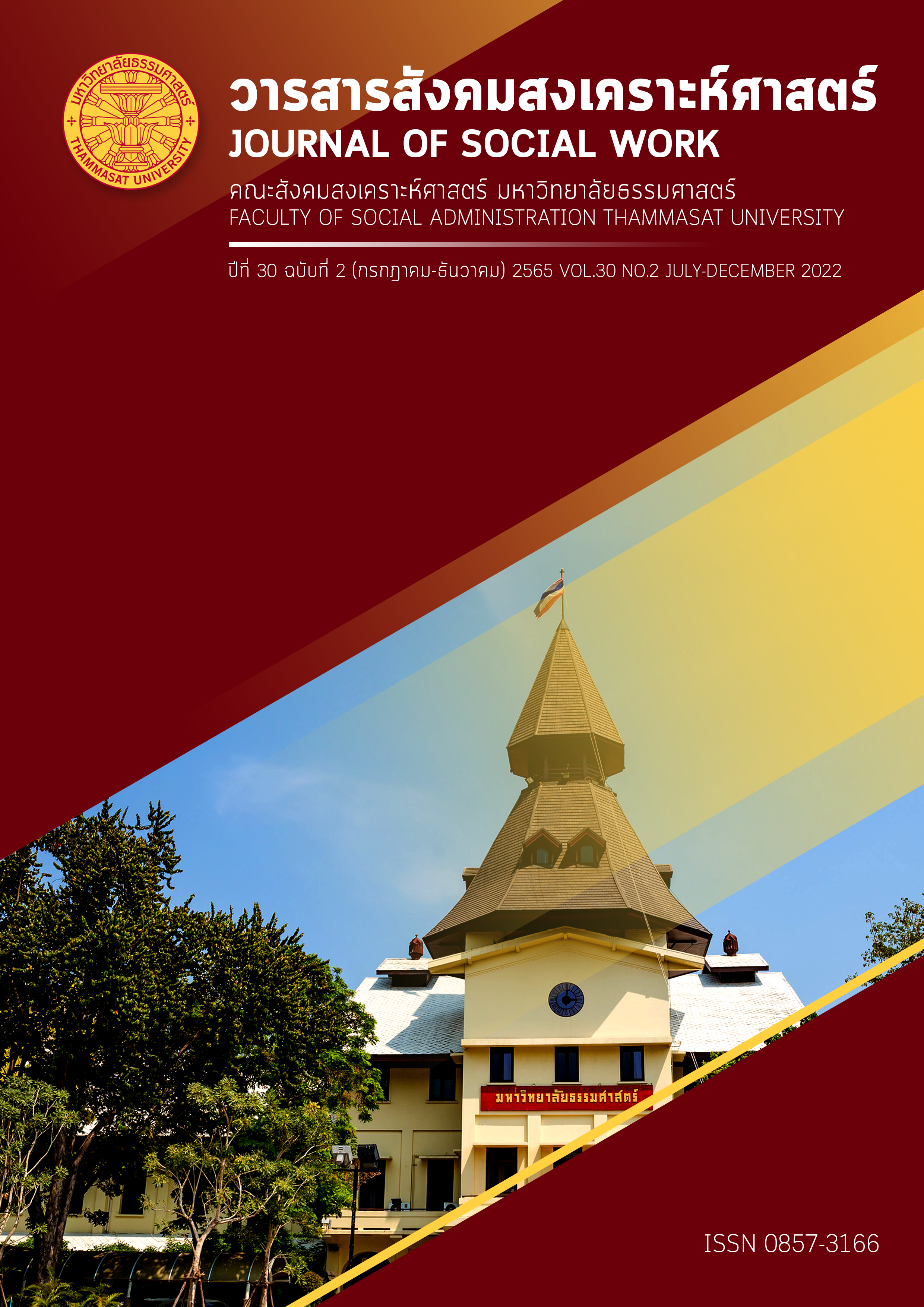Social Welfare for Capability of Female Elders Live Alone: Nakornpathom Disclosed
Keywords:
Social welfare, Capability approach, Female elders who live alone in NakornpathomAbstract
This research aims to study the mechanism of capability approach of female elders who live alone to become active aging, and the practical baseline of affiliated network partners who are responsible for this matter in Nakornpathom. The samples are 21 elders and 20 people from the elderly network. The research equipment are in-depth interviews, focus group interviews, and content analysis. The results demonstrate there are three components involving the capability approach. Firstly, role models of the elders propel social welfare for competency building. Secondly, the elderly network, including the elderly school emphasizes the inside capability building for a growth mindset development. Moreover, the elderly club conducts systematic management among network partners contributing to teamwork. Thirdly, the governmental network decentralizes its authority to a local network to collaboratively formulate the provincial development strategy by applying the capability approach index through each level of a development plan. The following problems are found: 5 elders are inaccessible to some dimensions of the welfare; 8 elders are considered as vulnerable in several aspects due to their mindset and context. For example, they are excluded from development projects, the elderly school does not motivate the elders to participate in hard and soft skill development activities, the elderly clubs do not have leaders who manage network of all districts, and the governmental network lacks an integrated database for indicating a circumstance of the situation.
There are four guidelines for the elderly network to contribute to the capability approach. First, the elders should receive a development of a growth mindset. Second, the elderly school should emphasize the development of an inside capability approach by having a curriculum that develops hard and soft skills. Third, the elderly club of all districts should follow systematic network management. Lastly, the governmental network should decentralize its authority to all affiliated stakeholders to collaboratively formulate the female elderly-capacity-oriented welfare.
References
กระทรวงการพัฒนาสังคมและความมั่นคงของมนุษย์. (2553). พรบ. ผู้สูงอายุ พ.ศ. 2546 (ฉบับแก้ไข พ.ศ. 2553) (พิมพ์ครั้งที่ 7). กรุงเทพฯ:
กรมกิจการผู้สูงอายุ, กระทรวงการพัฒนาสังคมและความมั่นคงของมนุษย์.
กระทรวงการพัฒนาสังคมและความมั่นคงของมนุษย์. (2553). แผนผู้สูงอายุแห่งชาติฉบับที่ 2 (พ.ศ.2545-2564) ฉบับปรับปรุงครั้งที่ 1 พ.ศ. 2552. กรุงเทพฯ: คณะกรรมการผู้สูงอายุแห่งชาติ, กระทรวงการพัฒนาสังคมและความมั่นคงของมนุษย์.
กระทรวงพัฒนาสังคมและความมั่นคงของมนุษย์. (2559). คู่มือโรงเรียนผู้สูงอายุ. กรุงเทพฯ: กรมกิจการผู้สูงอายุ, กระทรวงพัฒนาสังคมและความมั่นคงของมนุษย์.
กันนิษฐา มาเห็ม, ปิยนุช ภิญโย, ภาสินี โทอินทร์ และ พัฒนี ศรีโอษฐ์. (2563). ประสบการณ์ของผู้สูงอายุที่อาศัยอยู่ตามลำพังและความแตกต่างระหว่างหญิงชาย: การวิจัยชาติพันธุ์วรรณาอภิมาน. วารสารการพยาบาลและการดูแลสุขภาพ, 8(2), 138-147.
จุฑารัตน์ แสงทอง. (2560). สังคมผู้สูงอายุ (อย่างสมบูรณ์) ภาวะสูงวัยอย่างมีคุณภาพ. วารสารกึ่งวิชาการรูสมิแล. 38(1), 6-28.
ฐาปกรณ์ อ่วมสถิตย์. (2564). การพัฒนาทักษะซอฟต์สกิลด้วยการดำเนินงานโครงการจิตอาสาตามแนวทางจิตตปัญญาศึกษา. วารสารศิลปะศาสตร์ราชมงคลสุวรรณภูมิ, 3(1), 37-50.
ณัฐจรี สุวรรณภัฎ. (2558). สังคมวิทยาชีวิตประจำวัน: “รอยต่อ-รอยตัด” แนวทัศน์ทางสังคมวิทยาในงานศึกษาสังคมไทยร่วมสมัย. วารสารสังคมวิทยามานุษยวิทยา, 34(2), 71-99.
นันธิดา จันทร์สิริ. (2558). การจัดการเครือข่ายในกระบวนการนโยบายสาธารณะ. สารอาศรมวัฒนธรรมวลัยลักษณ์, 15(1), 145-153.
ปาจรีย์ ผลประเสริฐ และ วรางคณา จันทร์คง. (2561). บริหารจัดการชมรมผู้สูงอายุอย่างไรให้ประสบความสำเร็จ. วารสารชุมชนวิจัย, 12(2), 26-36.
พงษ์เทพ สันติกุล. (2564). ทฤษฎีรัฐสวัสดิการของ Paul Spicker. วารสารร่มพฤกษ์ มหาวิทยาลัยเกริก, 39(3), 193-215.
พีรพงษ์ แสงแก้ว, ศุภวิชญ์ มีศิริพันธุ์, กาญจนาพร วงอาจ และ โชติ บดีรัฐ. (2564). 7 กลไกการบริหารจัดการภาครัฐแนวใหม่. Journal of Roi Kaensarn Academi, 7(3), 386-397.
ภัทรพร ธนาคุณ และ บัวทอง สว่างโสภากุล. (2564). ความหวัง ความยืดหยุ่น ทักษะทางสังคม และความสำเร็จของการเป็นผู้สูงอายุของผู้สูงอายุในชมรมผู้สูงอายุแห่งหนึ่ง จังหวัดนนทบุรี. วารสารวิจัย มข. สาขามนุษย์ศาสตร์และสังคมศาสตร์ (ฉบับบัณฑิตศึกษา), 9(1), 70-80.
ภัทรพรรณ ทำดี. (2560). ตัวตน สังคม วัฒนธรรม เงื่อนไขสู่การสูงวัยอย่างมีศักยภาพของผู้สูงอายุจังหวัดเชียงใหม่. วารสารสังคมศาสตร์ คณะรัฐศาสตร์ จุฬาลงกรณ์มหาวิทยาลัย, 47(2), 109-131.
สุพิน ใจแก้ว. (2563). การพัฒนาชุดฝึกอบรมเสริมสร้างกรอบความคิดแบบเติบโตนักศึกษาคณะครุศาสตร์ มหาวิทยาลัยราชภัฎอุตรดิตถ์. วารสารสังคมศาสตร์และมานุษยวิทยาเชิงพุทธ, 5(11), 348-360.
สำนักงานคณะกรรมการพัฒนาการเศรษฐกิจและสังคมแห่งชาติ. (2564). รายงานความก้าวหน้าเป้าหมายการพัฒนาที่ยั่งยืนของประเทศไทยพ.ศ. 2559-2563. กรุงเทพฯ: สำนักงานสภาพัฒนาการเศรษฐกิจและสังคมแห่งชาติ.
สำนักงานคณะกรรมการพัฒนาการเศรษฐกิจและสังคมแห่งชาติ. (2562). ยุทธศาสตร์ชาติระยะ 20 ปี (พ.ศ. 2561-2580). กรุงเทพฯ: สำนักงานเลขานุการของคณะกรรมการยุทธศาสตร์ สำนักงานคณะกรรมการพัฒนาการเศรษฐกิจและสังคมแห่งชาติ.
สำนักงานสภาพัฒนาการเศรษฐกิจและสังคมแห่งชาติ. (2562). ดัชนีความก้าวหน้าของคนประจำปี พ.ศ. 2562. กรุงเทพฯ: สำนักงานสภาพัฒนาการเศรษฐกิจและสังคมแห่งชาติ.
สำนักงานสถิติจังหวัดนครปฐม. (2565). สังคมสูงวัยในจังหวัดนครปฐม. สืบค้นจาก https://www.nsonakhonpathom.com/statgis/main/download/upload/fileupload-20180910115917.pdf
สำนักงานสาธารณสุขจังหวัดนครปฐม. (2565). จำนวนประชากรแยกกลุ่มอายุและเพศจังหวัดนครปฐม. สืบค้นจาก http://nptho.moph.go.th/weboffice/frontend/web/index.php
สำนักงานจังหวัดนครปฐม (ม.ป.ป.) แผนพัฒนาจังหวัดนครปฐม (พ.ศ. 2561-2565) ฉบับทบทวน. สืบค้นจาก http://www.nakhonpathom.go.th/files/com_news_develop_plan/2019-05_fe54f0d4c7dbacd.pdf
สำนักงานจังหวัดนครปฐม (2565). ยุทธศาสตร์การพัฒนาจังหวัด. นครปฐม: ศูนย์ราชการจังหวัด สำนักงานจังหวัดนครปฐม. สืบค้นจาก http://www.nakhonpathom.go.th/content/strategy
Adana, F., Durmaz, S., Qzvurmaz, S., Akpınar, C. V., & Yesilfidan, D. (2022). Descriptors of living alone for Elders: based on Turkey national data. BMC Geriatrics, 22(1), 37.
Goswami, S., & Deshmukh, P. R. (2018). How "Elderly Staying Alone" Cope Up with their Age and Deteriorating Health: A Qualitative Exploration from Rural Wardha, Central India. Indian journal of palliative care, 24(4), 465–471.
Giddens, Anthony. (1984). The constitution of society: outline of the theory of structuration. Berkeley: University of California Press.
Sen, A. (2000). Development as freedom. New Delhi: Oxford University Press.
Sen, A. (2003). Development as Capability Expansion. In S. Fukuda-Parr & et al. (Eds.), Reading in Human Development. New Delhi and New York: Oxford University Press.
World Health Organization. (2002). Active ageing: A policy framework. Retrieved from http://apps.who.int/iris/bitstream/10665/67215/1/WHO_NMH_NPH_02.8.pdf
Downloads
Published
How to Cite
Issue
Section
License
Copyright (c) 2022 Journal of Social Work

This work is licensed under a Creative Commons Attribution-NonCommercial-NoDerivatives 4.0 International License.
The manuscripts published in the Social Work Journal is the copyright of the Social Work Journal, Thammasat University
Any article or opinion appeared in the Social Work Journal will solely be under the responsibility of the author The Faculty of Social Administration, Thammasat University and the editors do not need to reach in agreement or hold any responsibility.



